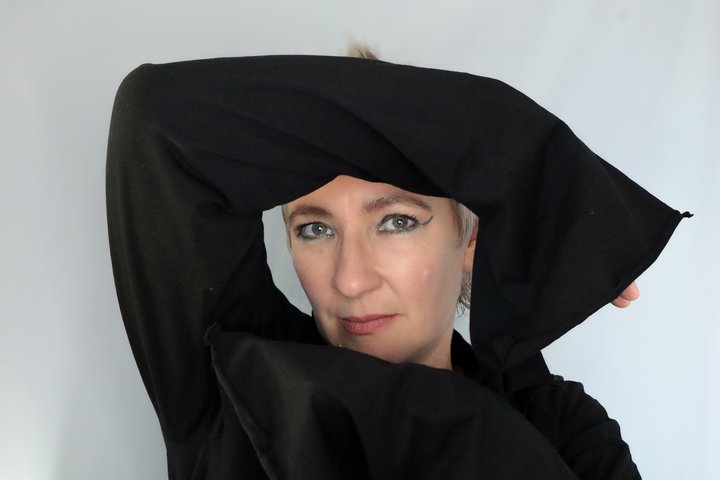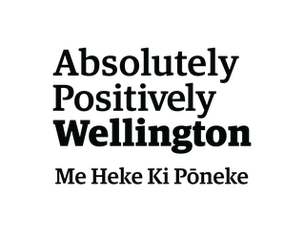25 June 2025
Jo Randerson’s new book is a creative non-fiction exploration of the power of art and creativity to create change, which Bret McKenzie has described as a ‘must-read for anyone in the arts.’ As a career artist, writer, theatre-maker and comedian, Jo’s experience in this field, as well as their thoughtful, academic rigor, makes them the ideal person to explore this topic.
I went to Brooklyn’s Vogelmorn Community Centre where Jo’s Barbarian Productions have their base, to catch up with Jo over a cup of tea.

I was fortunate to read an advance copy of Secret Art Powers, so I have my own thoughts about it but I started our interview by asking Jo what readers can expect.
“The creatives and artists who’ve read it have experienced validation,” Jo said. “When I was writing it, I thought, ‘creatives and artists don’t need to read this, it’s stuff they already know,’ but the artists who have read it say it makes them feel seen and heard. Other people who read it are saying it resonates with them on a human and spiritual level even though they aren’t artists.”
Jo explained that they were trying to mark out a place on the map that doesn’t get talked about enough, especially since COVID.
“People are always talking about stability and security and there’s this kind of risk aversion that comes around times of crisis. This book is trying to place us in a more brave, courageous risk-taking place, where we honour our instincts, the way artists do. It’s a philosophical book rather than a book that tells you how to be an artist – other books do that, like The Artist’s Way...,this is more broad principles.
“I don’t think I’m saying anything especially new in the book or putting anything out there that hasn’t already been voiced. I feel like I’m articulating deep, human principles that have been pushed under the surface and forgotten about because we’ve absorbed this western, patriarchal, consumer culture model.
“Principles like toughness and strength always get valued, whereas vulnerability is so important. So is openness and flexibility. The business world talks so much about being agile, but artists really know how to do that, especially dancers. It’s a curious environment at the moment because I know New Zealanders really value the arts, but we never fund it adequately. Artists helped everyone survive emotionally and spiritually during COVID but are still so under-resourced. They’re a pool that society leans on hugely, yet art is still exoticised and mystified. In Secret Art Powers, I’ve dug into the core principles I’ve found in my arts practice so far and have tried to articulate them in a way that other people can see and value .”
Secret Art Powers began its life as a series of live performances, I asked what the process was to get their ideas from that iteration into a book.
“The project was always going to be a book, but I wanted to build it off a live audience. In a clown process, when you make something you show it to people as soon as you can for feedback, then you adapt. You are always responding to your audience. This is different to a lot of theatre processes where you develop the show before revealing it to the world. I wanted to try this with writing as well, so I created these live events to test the philosophical ideas I was forming in front of an audience. The original goal was to talk about one Secret Art Power at a time, and then to interview a local artist who is an exemplar of that power. That artist might totally disagree with me, and it could end up as a debate.”
Unfortunately, COVID cut this performance series short and rather than have one event per power, several were rolled into one and one had to be cancelled.
“We also made short animations. There’s an awesome artist from Greytown, Steffen Kreft, and he created a process for us to make the animations together. In the same way that speaking my thoughts on stage helped me test out my ideas, making the animations also helped me refine the concepts. I had to condense each chapter into about 30 seconds which meant I basically had to make it a poem. It was a great challenge. The whole process has felt multi-pronged, like a wheke – it has all these arms to it, and they’ve all been growing at different times.
You can view one of the animations here.
"Sometimes writing the poem helped me figure out exactly what a chapter was about because summarising something is extremely clarifying. It took a while for all the strands to emerge, but all the iterations helped the book grow and become clearer. The book itself is another iteration because it has crowd-sourced illustrations in it and that added another layer.” Jo explains the vision of their designer, Sarah Maxey, whose timely input deeply shaped the finished product. “We had six sessions with kids, adults, anyone who wanted to come along and Sarah would ask them to, for example, draw a moth eating through clothes (which was one of the metaphors in the book), and we’d give them three minutes to finish. It was so much fun, and this construction process was another arm of the wheke that I had not predicted. Sarah was amazing to work with.”
I asked Jo what their aspirations are for the book.
“My first ambition is to get it launched and read by some people, get some feedback. Quite a few people have said they think it could go further, so I’m interested in that too. I think the writing can resonate outside the New Zealand context. The world is at a very stressed time in our history, yet there are some beautiful pieces of solidarity happening. I guess my greatest hope for the book is that it could help people hold onto the things that are important to them. That’s why the last chapter is about imagination and hope. I almost called it Faith, which is a power we desperately need right now, not just to say ‘things could be different’ but to actually believe in that.’
“What I’m writing has a political edge to it. People often say there should be no politics in art, but there always is. Art might not be overtly political, but it always exists in a warmer layer underneath the surface.”
Almost every chapter in the book has a section about clowns or fools, and I asked Jo if this was a reference to the way in classical literature it’s always the fool character who can see and articulate the truth in the way wiser characters can’t.
“Yes,” they said. “That’s a character and archetype that I deeply love. Comedy is never seen as high art, yet some comedians are the most incredible crafters of story. People like James Nokise and the way he manages to weave his storytelling with politics and emotion, and make it highly accessible.” ”
Finally, I asked what’s next for Jo.
“Our new show, Speed is Emotional, is about to go on tour. It’s unusual that both these projects have birthed at the same time, but partly intentional, because we wanted the book to be available at the show. People have asked if the projects are related, and at first, I said no. But when I thought more about it, they are in a way. Speed is Emotional is an even more personal exploration about creativity, healing and magical art-powers. In a way, writing the book helped the show come out. Art is like a constant excavation of your own soul in the particular context that you live in. But yes, I do think there’s more to do with the book. Like a radio presentation or something. Maybe a return to the stage with all six powers?”
Whatever comes next, I have no doubt it will be interesting, exciting and above all, creative.
Secret Art Powers will be in bookstores in July and can be purchased here.
-by Kate Larkindale


